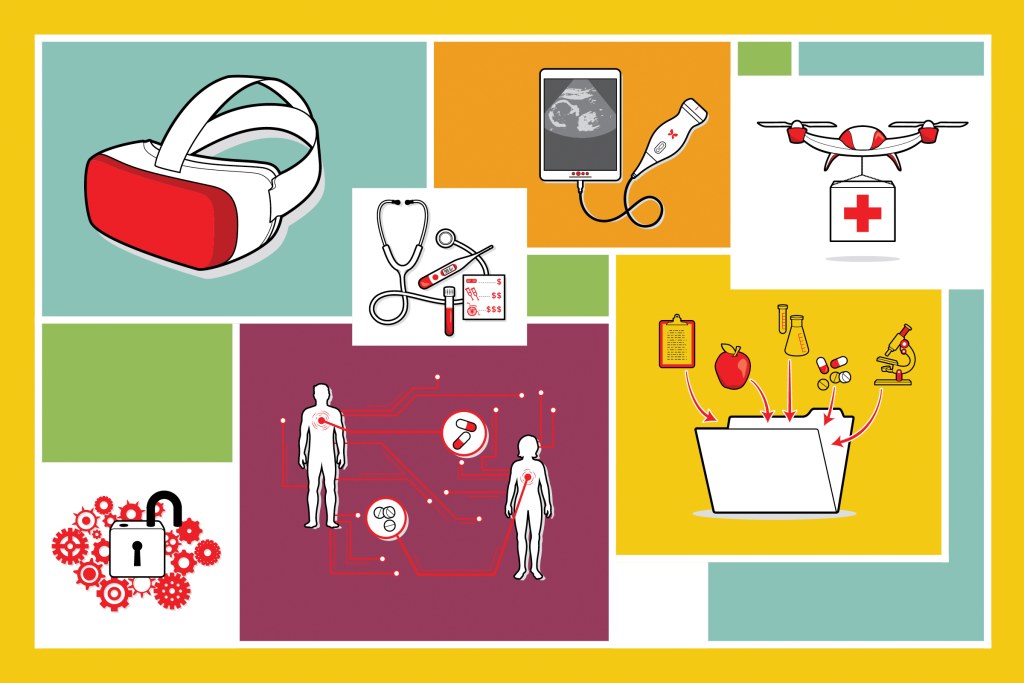Revolutionizing Healthcare With Technology Innovation For Health: Unleash The Power Of Click To Action!
Technology Innovation for Health
Introduction
Hello Readers,
Welcome to this article on technology innovation for health. In today’s fast-paced world, advancements in technology have revolutionized the healthcare industry, leading to significant improvements in patient care, diagnosis, and treatment. From wearable devices to artificial intelligence, technology has enabled healthcare professionals to provide more efficient and effective services.
1 Picture Gallery: Revolutionizing Healthcare With Technology Innovation For Health: Unleash The Power Of Click To Action!

In this article, we will explore the various aspects of technology innovation for health, including its benefits, applications, and potential challenges. So, let’s dive in and discover how technology is shaping the future of healthcare.
What is Technology Innovation for Health?
Technology innovation for health refers to the development and implementation of new technologies in the healthcare sector to improve patient outcomes, enhance the delivery of care, and streamline healthcare processes. It encompasses a wide range of technologies, including telemedicine, electronic health records, remote monitoring devices, and medical imaging systems.
Telemedicine
Telemedicine is a key component of technology innovation for health. It enables healthcare providers to deliver medical services remotely using telecommunications technology. With telemedicine, patients can consult healthcare professionals via video calls, receive diagnoses, and even get prescriptions without visiting a physical clinic.
Electronic Health Records
Image Source: twimg.com
Electronic health records (EHRs) have transformed the way patient information is stored and accessed. EHRs allow healthcare providers to have instant access to a patient’s medical history, test results, and treatment plans. This improves coordination between healthcare providers, reduces errors, and enhances patient safety.
Remote Monitoring Devices
Remote monitoring devices, such as wearable fitness trackers and smartwatches, play a crucial role in technology innovation for health. These devices enable individuals to track their health parameters, such as heart rate, sleep patterns, and physical activity, in real-time. Healthcare professionals can use this data to monitor patients remotely and provide personalized care.
Medical Imaging Systems
Medical imaging systems, such as X-ray machines, ultrasound devices, and magnetic resonance imaging (MRI) scanners, have undergone significant advancements in recent years. These technologies enable healthcare professionals to visualize internal body structures, detect abnormalities, and assist in accurate diagnoses. They provide a non-invasive and painless way to identify various health conditions.
Who Benefits from Technology Innovation for Health?
Technology innovation for health benefits various stakeholders in the healthcare ecosystem:
Patients
Patients are the primary beneficiaries of technology innovation in healthcare. They can access quality care remotely, receive timely diagnoses, and enjoy personalized treatment plans. This leads to improved health outcomes, reduced healthcare costs, and enhanced patient satisfaction.
Healthcare Professionals

Image Source: time.com
Healthcare professionals, including doctors, nurses, and specialists, benefit from technology innovation by having access to comprehensive patient data, streamlined workflows, and decision support tools. This improves their efficiency, reduces administrative burdens, and enables them to deliver more accurate and personalized care.
Healthcare Organizations
Healthcare organizations, such as hospitals and clinics, benefit from technology innovation through improved operational efficiency, reduced costs, and enhanced patient engagement. Digital solutions help in better resource management, optimized scheduling, and improved communication between healthcare providers.
When to Implement Technology Innovation for Health?
Implementing technology innovation for health can be done at various stages:
Innovation and Development
The initial stage involves the research, development, and testing of new technologies. This includes conducting clinical trials, refining prototypes, and ensuring regulatory compliance. It is essential to involve healthcare professionals, patients, and technology experts in this process to ensure the successful implementation of innovative solutions.
Integration and Adoption
Once the technologies have been developed, they need to be integrated into existing healthcare systems and adopted by healthcare providers. This requires training and education for healthcare professionals, infrastructure upgrades, and change management strategies. A phased approach is often adopted to minimize disruptions and ensure a smooth transition.
Continuous Improvement
Technology innovation for health is an ongoing process that requires continuous improvement and adaptation. Regular updates, system enhancements, and feedback from users are essential to ensure that the technologies remain effective and aligned with evolving healthcare needs.
Where is Technology Innovation for Health Being Implemented?
Technology innovation for health is being implemented in various healthcare settings:
Hospitals and Clinics
Hospitals and clinics are at the forefront of technology adoption in healthcare. They utilize electronic health records, telemedicine, and advanced diagnostic imaging systems to provide comprehensive care to patients. These technologies improve the efficiency of healthcare delivery and enable better patient outcomes.
Home Healthcare
Technology innovation has also extended to home healthcare settings. Remote monitoring devices and telehealth services enable individuals to receive care in the comfort of their homes. This is particularly beneficial for patients with chronic conditions or limited mobility.
Rural and Underserved Areas
Technology innovation for health plays a crucial role in bridging the healthcare gap in rural and underserved areas. Telemedicine allows patients in remote locations to access healthcare services without the need for long-distance travel. This improves healthcare access and reduces disparities in care.
Why is Technology Innovation for Health Important?
Technology innovation for health is essential for several reasons:
Improved Patient Care
By leveraging technology, healthcare providers can deliver more accurate diagnoses, personalized treatment plans, and proactive interventions. This leads to improved patient outcomes, reduced hospital readmissions, and better quality of life for patients.
Efficiency and Cost Savings
Technology innovation streamlines healthcare processes, reduces administrative tasks, and eliminates redundancies. This improves efficiency, reduces costs, and allows healthcare providers to allocate resources more effectively.
Enhanced Access to Care
Technology innovation for health enables individuals to access healthcare services regardless of their geographical location. This is particularly beneficial for individuals in remote or underserved areas who may face barriers to traditional healthcare delivery.
Advancements in Medical Research
Technological advancements in healthcare facilitate medical research and innovation. Researchers can collect and analyze large datasets, collaborate globally, and develop new therapies and interventions. This accelerates the pace of medical discoveries and improves overall healthcare outcomes.
How is Technology Innovation for Health Implemented?
Implementing technology innovation for health involves various steps:
Research and Development
Research and development play a crucial role in technology innovation for health. Scientists, engineers, and healthcare professionals collaborate to develop and refine new technologies, ensuring that they meet the needs of patients and healthcare providers.
Pilot Programs and Testing
Pilot programs allow healthcare organizations to test new technologies on a small scale before implementing them widely. This helps identify any challenges or issues and allows for necessary modifications or improvements before full-scale deployment.
Training and Education
Healthcare professionals need to be trained on how to use and leverage new technologies effectively. Training programs, workshops, and continuing education initiatives help healthcare providers develop the necessary skills and competencies to leverage technology in their practice.
Regulatory Compliance
Technology innovation for health must comply with strict regulatory standards to ensure patient safety and data security. Healthcare organizations must adhere to privacy regulations, such as the Health Insurance Portability and Accountability Act (HIPAA), and comply with guidelines set by regulatory authorities.
Advantages and Disadvantages of Technology Innovation for Health
Advantages
1. Improved patient outcomes through accurate diagnoses and personalized treatment plans.
2. Enhanced access to healthcare services, especially for individuals in remote or underserved areas.
3. Streamlined healthcare processes, leading to improved efficiency and reduced costs.
4. Increased patient engagement and empowerment through remote monitoring and self-care tools.
5. Accelerated medical research and innovation, leading to the development of new therapies and interventions.
Disadvantages
1. Potential privacy and security risks associated with the collection and storage of patient data.
2. The digital divide may limit access to healthcare technologies for certain populations.
3. The cost of implementing and maintaining technology infrastructure can be a barrier for some healthcare organizations.
4. Technology glitches or system failures can disrupt healthcare delivery and negatively impact patient care.
5. Healthcare professionals may require additional training and support to adapt to new technologies, leading to a learning curve.
Frequently Asked Questions (FAQ)
Q1: Can telemedicine completely replace in-person doctor visits?
A1: While telemedicine offers convenient access to healthcare, it cannot replace all in-person visits. Certain medical conditions may require physical examinations or diagnostic tests that cannot be conducted remotely.
Q2: Are wearable fitness trackers accurate in measuring health parameters?
A2: Wearable fitness trackers provide general indications of health parameters, but their accuracy may vary. They can be used as motivational tools for personal fitness goals, but for precise medical measurements, professional-grade devices should be utilized.
Q3: How does technology innovation for health impact data privacy?
A3: Data privacy is a critical concern in technology innovation for health. Healthcare organizations must adhere to strict privacy regulations and implement robust security measures to protect patient data from unauthorized access or breaches.
Q4: What challenges do healthcare organizations face when implementing technology innovation?
A4: Healthcare organizations may face challenges such as the cost of implementation, resistance to change among healthcare professionals, interoperability issues between different systems, and ensuring the security and privacy of patient data.
Q5: How can technology innovation improve healthcare access in rural areas?
A5: Technology innovation, such as telemedicine, can bridge the healthcare gap in rural areas by allowing patients to consult healthcare professionals remotely. This reduces the need for travel and enables timely access to medical services.
Conclusion
In conclusion, technology innovation for health has transformed the healthcare landscape, offering numerous benefits for patients, healthcare professionals, and organizations. From telemedicine to remote monitoring devices, technology has revolutionized healthcare delivery, improving patient outcomes and enhancing access to care. While there are challenges to overcome, the potential for continued innovation in healthcare technology is vast. It is crucial for stakeholders to embrace these advancements and work together to ensure that technology continues to improve healthcare for all.
Final Remarks and Disclaimer
Technology innovation for health holds great promise for the future of healthcare. It has the potential to revolutionize how we access and receive medical care, improve patient outcomes, and enhance the overall health of individuals and communities. However, it is important to acknowledge that technology is not a substitute for personalized medical advice and care from qualified healthcare professionals. Readers are advised to consult their healthcare providers for individualized recommendations and treatment plans. The information provided in this article is for informational purposes only and should not be considered as medical advice.
This post topic: Technology Innovation

